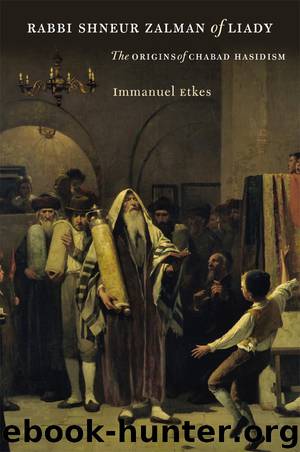Rabbi Shneur Zalman of Liady by Etkes Immanuel; Green Jeffrey M.;

Author:Etkes, Immanuel; Green, Jeffrey M.; [Etkes, Immanuel; Green, Jeffrey M.;]
Language: eng
Format: epub
Publisher: Brandeis University Press
Published: 2015-10-10T19:41:11+00:00
Most likely the information and evaluation about the Hasidim and Hasidism that Bulgakov presented in the name of “popular opinion” derived from gentiles, whose acquaintance with Hasidism was slender, and perhaps from Jews who were hostile to it. Nevertheless, the fact that Bulgakov decided to write these things to Lopukhin reflects his attitude toward Hasidism.
When the findings of the investigations of the governors of White Russia and of Lithuania are combined, it seems that even though they did not discover anything concrete in their investigations, they continued to attribute great importance to the suspicion that Hasidism was a secret and subversive sect. The combination of the defamatory letter with the cultural gap that made it difficult for officials to investigate the true character of Hasidism nourished their suspicions. These were supported by the accusations of the mitnagdim, who repeatedly represented the Hasidim as innovators and deviants. In addition, the government was suspicious of any supposedly subversive sect. Thus it is not surprising that the testimony regarding the enormous authority that Shneur Zalman enjoyed was seen as confirming these suspicions. Further confirmation of the suspicions was ostensibly found in his connections with the Land of Israel. The open tie with the Land of Israel was blown up into an imaginary tie with other countries in the Ottoman Empire, which was Russia’s traditional enemy.66
In a letter sent to Lopukhin on October 28, Bulgakov confirmed that he had received the document containing Shneur Zalman’s answers, and he promised to have it translated soon. He also wrote that according to his estimation, the seven Hasidim whom he had sent to St. Petersburg had reached Riga. Since in the meantime he had been ordered not to send them on to St. Petersburg, he gave instructions to have them detained in Riga for the time being.67 On the same day that Bulgakov sent this letter to Lopukhin, another letter was sent to him, in the margins of which appeared the signature: “Willenska Koftsa the Wife of Rephaelovtsa, Esther.” This Esther was the wife of Meir Ben Refael, who was regarded as the wealthiest and most estimable of the Hasidim of Vilna.68 The writer, who presented herself as the spokeswoman for the wives of all arrested Hasidim, began her letter with the following statement: “Several days ago I resolved to take a daring step in order to ease my oppressive situation and decided to send a request to the great sovereign of Russia along with comments that explain the situation of the miserable husbands and relatives who are imprisoned, having committed no crime, because of the vindictive accusation of the Vilna Kahal and the good relations of the mayor with the head of the Kahal. Following that night, when our husbands were taken to an unknown place, our sorrows have become absolute despair.”69 The letters that Esther, the wife of Meir Ben Refael, sent to Lopukhin and the czar were most probably composed and sent in consultation with the Hasidim who were trying to free Shneur Zalman and the other detainees.
Download
This site does not store any files on its server. We only index and link to content provided by other sites. Please contact the content providers to delete copyright contents if any and email us, we'll remove relevant links or contents immediately.
| Africa | Americas |
| Arctic & Antarctica | Asia |
| Australia & Oceania | Europe |
| Middle East | Russia |
| United States | World |
| Ancient Civilizations | Military |
| Historical Study & Educational Resources |
Cecilia; Or, Memoirs of an Heiress — Volume 1 by Fanny Burney(32396)
Cecilia; Or, Memoirs of an Heiress — Volume 3 by Fanny Burney(31774)
Cecilia; Or, Memoirs of an Heiress — Volume 2 by Fanny Burney(31741)
The Secret History by Donna Tartt(18786)
Sapiens: A Brief History of Humankind by Yuval Noah Harari(14182)
Leonardo da Vinci by Walter Isaacson(13126)
The Radium Girls by Kate Moore(11886)
Sapiens by Yuval Noah Harari(5273)
How Democracies Die by Steven Levitsky & Daniel Ziblatt(5105)
The Wind in My Hair by Masih Alinejad(5019)
Homo Deus: A Brief History of Tomorrow by Yuval Noah Harari(4785)
Endurance: Shackleton's Incredible Voyage by Alfred Lansing(4646)
The Silk Roads by Peter Frankopan(4424)
Man's Search for Meaning by Viktor Frankl(4371)
Millionaire: The Philanderer, Gambler, and Duelist Who Invented Modern Finance by Janet Gleeson(4322)
The Rape of Nanking by Iris Chang(4116)
Joan of Arc by Mary Gordon(3995)
The Motorcycle Diaries by Ernesto Che Guevara(3955)
Hitler in Los Angeles by Steven J. Ross(3879)
